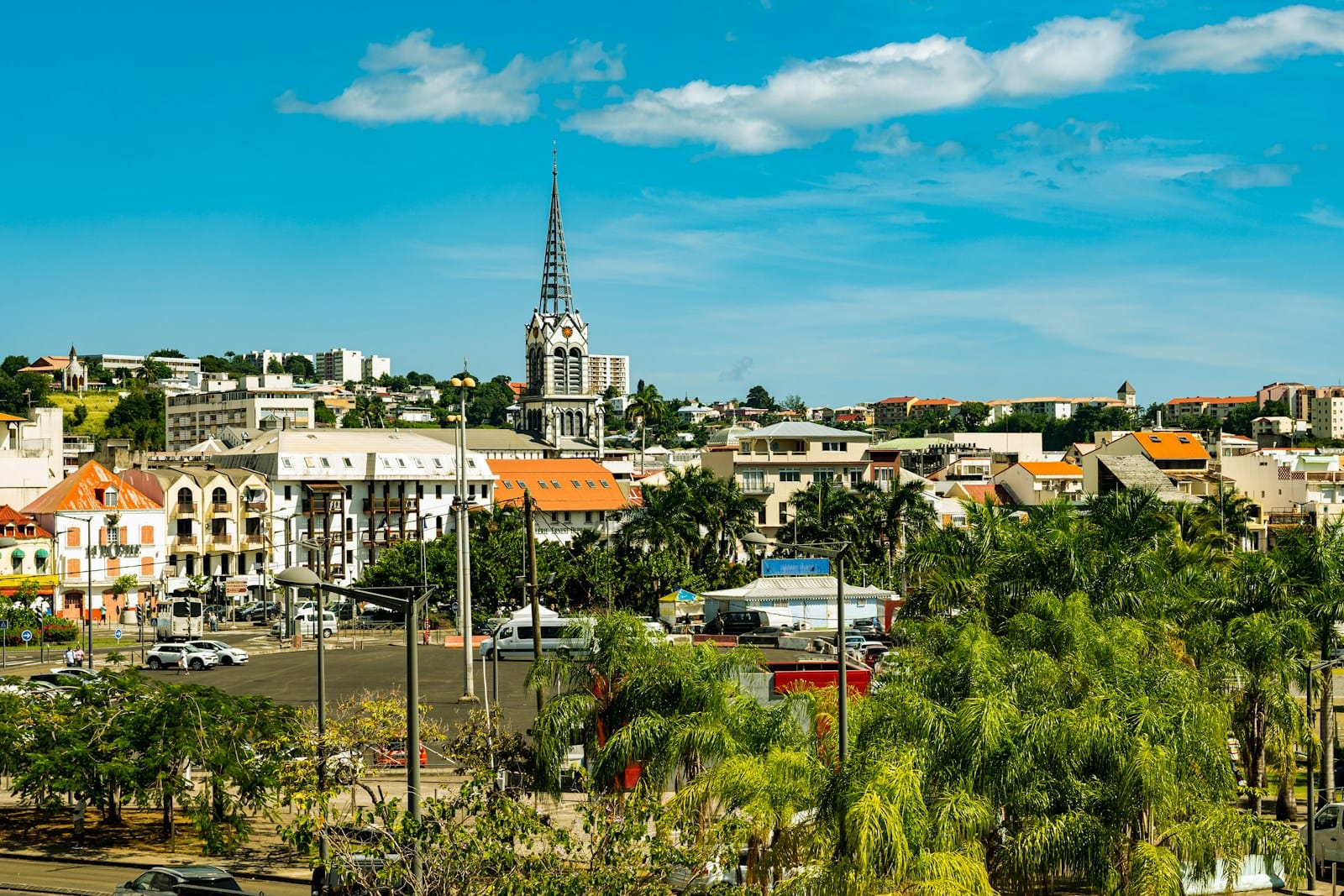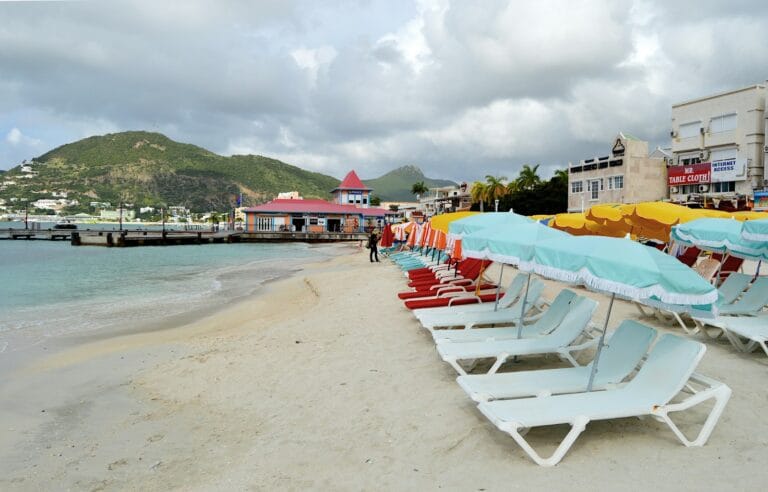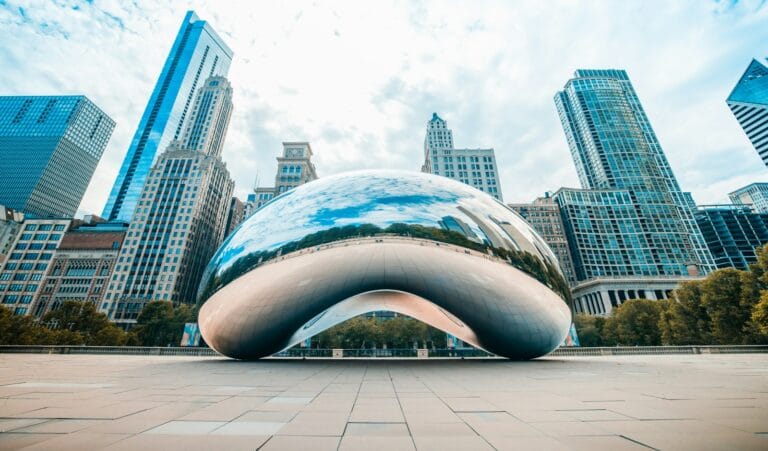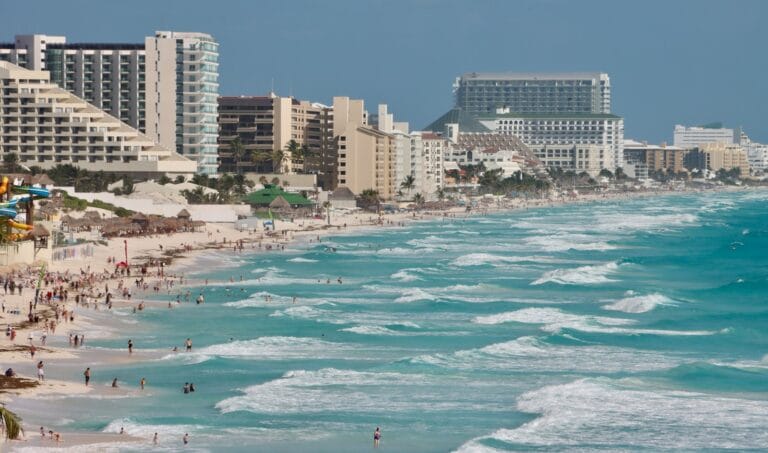Martinique Travel Guide: French Caribbean Flair with Volcanic Soul
Intro to Martinique Travel Guide
Martinique is the rare Caribbean island where French elegance, Creole spirit, and natural drama blend effortlessly. From its black-sand beaches and Mount Pelée hikes to spice markets and seaside jazz, this overseas region of France offers much more than a typical tropical escape — it’s a multi-sensory dive into Caribbean culture with a French twist.
Start planning your island adventure with our complete Martinique tour guide — uncover top beaches, local cuisine, lush hikes, cultural towns, and real-deal island rhythm.
Regions to Explore in Martinique
Centre | Nord-Atlantique | Nord-Caraïbe | Sud-Caraïbe | Sud-Est
💡Quick Facts:
Destination: Martinique
Continent: North America (Caribbean)
Country: France (Overseas Department/Region)
Capital: Fort-de-France
Regions: Northern Rainforests, Central Plains, Southern Beaches
Area: 1,128 km²
Population: ~370,000
Density: ~330/km²
Official Language: French
Regional Languages: Creole (Martinican Creole widely spoken)
Currency: Euro (EUR)
Time Zone: Atlantic Standard Time (UTC-4)
Known For: Mount Pelée volcano, rum distilleries, Creole culture, beaches, yachting, UNESCO-listed yole sailing (intangible heritage)
Airports: Martinique Aimé Césaire International Airport (FDF)
Climate: Tropical; wet season June–Nov, dry season Dec–May
🛂Arrival Info:
Entry: As an overseas region of France, Schengen rules apply.
Visa-Free: EU/EEA, UK, US, Canada, and most Latin American travelers (short stays up to 90 days).
Requirements: Passport valid 3+ months, onward/return ticket.
Customs: Duty-free allowances similar to France. Visa portal.
🏥Health Info:
Vaccines: Routine vaccines + Hepatitis A, Typhoid. Yellow fever certificate required if arriving from endemic regions.
Risks: Occasional dengue and chikungunya outbreaks.
Hospitals: Modern facilities in Fort-de-France; clinics across island.
Insurance: Recommended for evacuation and natural disaster coverage.
🚑 Check travel insurance options for travel emergencies, delays, and medical needs abroad — Get coverage here
💉 Stay Informed with Official Updates: WHO – International Travel & Health | CDC – Travel health updates
🚨Travel Advisory:
Safety: Generally safe; petty theft in urban/tourist areas.
Natural Risks: Hurricane season June–Nov. Volcanic hazards from Mount Pelée monitored but currently stable.
Protests: Labor strikes and road blockages can occur, especially in Fort-de-France.
🌍Track Real-Time Official Updates: US Travel Advisory | UK Foreign Travel Advice | Government of Canada | NZ SafeTravel
🥳Holidays:
Labor Day: May 1.
Abolition of Slavery: May 22 (island-wide commemoration).
Bastille Day: July 14 (French national holiday).
Assumption of Mary: Aug 15.
All Saints’ Day: Nov 1.
Christmas Day: Dec 25.
Carnival: Feb/March, vibrant island-wide parades and music.
💰Visitor Info:
Currency: Euro; ATMs and credit cards widely accepted.
Costs:
Budget: $60–90/day
Mid-range: $120–180/day
Luxury: $250+ per day (resorts, yachts, gourmet dining)
Tipping: Service charge included; rounding up is customary.
Tourist Tax: Small nightly fee included in hotel bills.
🛫Airports:
Aimé Césaire International Airport (FDF) – Fort-de-France
Main Gateway: Handles flights from France, U.S., Canada, and other Caribbean islands
Distance from City: ~10 km (6 mi) southeast of Fort-de-France
Airlines: Air France, Air Caraïbes, Corsair, American Airlines, Air Canada, LIAT
Ground Transport: Car rentals, taxis, and shuttles available
🧳 Delayed or canceled flight? Check if you’re eligible for compensation
🚍Transport:
Car Rentals: Most practical way to explore; right-hand driving.
Buses/Collectifs: Minibuses link towns; limited schedules on weekends.
Taxis: Expensive, no rideshare apps.
Ferries: Connect to Guadeloupe, Dominica, Saint Lucia.
Domestic Flights: Not needed; island compact.
🚗 Book reliable airport transfers and in-city rides in advance. Reserve your ride here
🛰️Connectivity:
SIM/eSIM: Orange, Digicel, SFR offer prepaid plans; coverage strong.
Wi-Fi: Common in hotels/cafes; reliable in urban zones.
Roaming: EU roaming applies for EU SIM cards.
🛜 Stay connected abroad with affordable eSIM data packs. Get your eSIM here
📜Laws & Etiquette:
Alcohol: Rum is cultural; legal drinking age 18.
Dress Code: Casual, but beachwear only at beaches.
Language: French is official; learning some Creole expressions appreciated.
LGBTQ+: Legal protections as in France; acceptance varies in rural areas.
Social Norms: Greet with “Bonjour” before requests; politeness valued.
👮Emergency Info:
Emergency Number: 112 (EU standard).
Police: 17; Fire/Ambulance: 18/15.
Tourist Office: Fort-de-France, +596 596 61 61 77.
Hospitals: CHU de Martinique (Fort-de-France).
Consulates: French overseas territory – most embassies in Paris, limited consular services locally.
🏛️ Use embassy locator tools: Embassies Worldwide
🌞Weather:
Dry Season (Dec–May): Best for beaches, sailing, hiking.
Wet Season (Jun–Nov): Heavy rains, hurricanes possible.
Temperatures: 24–31°C year-round.
Sea Conditions: Warm waters, prime diving/snorkeling Dec–Apr.
🌦️ Stay prepared—check the weather forecast for your destination — Weather Forecast
Martinique by Region – Where to Go
Though relatively compact, Martinique’s regions feel distinct — shaped by volcanoes, history, and coastline.
Fort-de-France & Central Martinique
The capital is a lively blend of colonial heritage, markets, and modern life. Explore the Schoelcher Library, St. Louis Cathedral, and Savane Park. Just east, Le Lamentin is the transport and commercial hub. This area is perfect for urban culture, shopping, and launching day trips.
Les Trois-Îlets & the Southwest
Across the bay from Fort-de-France, Les Trois-Îlets is a tourism hotspot — home to beach resorts, boutiques, golf, and the Pagerie Museum (birthplace of Napoleon’s empress). Nearby, Anse Mitan and Pointe du Bout offer boat trips, snorkeling, and sunset views.
Le Diamant & Les Anses-d’Arlet
This scenic stretch along the Caribbean coast is postcard-perfect. Le Diamant’s beach faces the iconic Diamond Rock, while Les Anses-d’Arlet is a snorkeler’s dream with calm bays, turtles, and colorful reefs. Ideal for beach lovers and casual snorkeling.
Northern Martinique – Mount Pelée & Saint-Pierre
A dramatic, volcanic region of lush rainforest and tragedy. Climb Mount Pelée, visit the ruins of Saint-Pierre, and stop in sleepy towns like Le Prêcheur or Ajoupa-Bouillon. Perfect for hikers, history lovers, and nature fans.
Eastern Atlantic Coast
Wild and windblown, this less-touristed coast is popular for surfing, solitude, and rum distilleries. Check out La Trinité, Le Robert, or Presqu’île de la Caravelle for eco-lodges, kite spots, and mangrove tours.
Southern Tip – Sainte-Anne & Les Salines
This is the island’s classic tropical zone. Plage des Salines is Martinique’s most famous beach — soft white sand and calm turquoise sea. Nearby Sainte-Anne offers beach bars, markets, and access to coastal hikes like the Trace des Caps.
Top Places to Visit in Martinique
These must-see destinations represent the best places to visit in Martinique for every type of traveler.
Cultural Towns
- Fort-de-France – Historic, walkable, and full of energy
- Saint-Pierre – The “Pompeii of the Caribbean,” frozen in volcanic time
- Trois-Îlets – Birthplace of Empress Joséphine, home to Creole crafts and museums
Beaches & Bays
- Plage des Salines – Dreamy white-sand beach at the island’s tip
- Anse Dufour & Anse Noire – Turtle snorkeling and photogenic contrast of black and white sands
- Le Diamant – Long, breezy beach with open ocean views and iconic rock
Hiking & Nature
- Mount Pelée – Climb into cloud forests and volcanic craters
- Presqu’île de la Caravelle – Easy loop hikes with ocean views and dry forest flora
- Balata Gardens – Lush botanical park near Fort-de-France with canopy walkways
Rum & Plantation Culture
- Habitation Clément – Elegant estate with rum tastings, sculpture gardens, and history
- Depaz Distillery – In the shadow of Mount Pelée with panoramic views
- La Mauny – Traditional rhum agricole experience in the south
How to Choose Where to Go in Martinique
Martinique’s small size makes it easy to explore, but trip styles vary depending on interest and base.
- For Beach Lovers & Relaxation:
Stay in Sainte-Anne or Les Anses-d’Arlet for easy access to clear water and gentle coves. - For Nature & Adventure:
Base in Saint-Pierre or Le Morne-Rouge to access hiking trails, waterfalls, and the volcano. - For Food, Culture & Nightlife:
Stay near Fort-de-France or Les Trois-Îlets for culinary variety, bars, and museums. - For Surfers & Solitude:
Explore the Atlantic coast around La Trinité or Le François — wilder, windier, and less touristy. - For Multi-Day Exploration:
Rent a car and spend time in both the north and south — they feel like two different worlds.
How to Get Around Martinique
While public transport exists, renting a car is essential for exploring freely.
Car Rentals
- Most visitors rent at Aimé Césaire Airport (FDF) or in Trois-Îlets
- Roads are well-paved, but mountain curves require caution
- Driving is on the right, and signs are in French
Ferries & Water Taxis
- Vedettes Tropicales connect Fort-de-France with Trois-Îlets, Anse Mitan, and Pointe du Bout
- Great for avoiding traffic and getting scenic views
Buses & Collective Taxis
- TCSP is a modern bus line linking Fort-de-France with the airport and some suburbs
- Taxi collectifs (shared vans) run between towns but are infrequent and informal
Walking & Hiking
- Towns like Saint-Pierre, Fort-de-France, and Sainte-Anne are walkable
- For trails like Trace des Caps or Mount Pelée, use proper hiking gear and go early
Apps & Resources:
- Google Maps for driving, though signage may differ
- Martinique Transport app for buses and TCSP routes
- Download offline maps if exploring rural or northern areas
Travel Budget & Costs in Martinique
As an overseas region of France, cost to travel in Martinique is on par with mid-range Europe — but budget options are growing.
Budget Travelers (€50–90/day)
- Local guesthouses or B&Bs: €40–60
- Creole meals at snack bars: €8–12
- Free beaches and hikes
- Use ferries instead of cars for short trips
Mid-Range Travelers (€100–180/day)
- Boutique hotels or beach rentals: €80–130
- Meals at mid-tier restaurants: €20–30
- Entry to distilleries, gardens, museums
- Car rental for multi-day loops
Luxury Travelers (€200–400+/day)
- Oceanfront resorts or villas: €200+
- Fine dining, private tours, spa services
- Guided volcano hikes or catamaran charters
Cost-Saving Tips
- Travel in shoulder season (May–June or Sept–Oct)
- Cook some meals if staying in an Airbnb
- Combine local ferries with occasional taxi rides
- Look for combo passes for gardens and cultural sites
Best Time to Visit Martinique
Martinique’s tropical climate makes it a year-round destination, but seasonal changes affect crowds, costs, and weather.
Dry Season (December–April)
- Best time to visit Martinique for sunshine and festivals
- Warm, dry days averaging 27–30°C (80–86°F)
- High season, so book accommodations early
- Carnival (Jan/Feb) and Easter are cultural highlights
Shoulder Season (May–June)
- Fewer tourists and lower prices
- Occasional showers, but mostly sunny
- Great time for hiking and quieter beaches
Wet Season (July–November)
- Lush, green landscapes and off-season deals
- Highest rainfall in September and October
- Hurricane season, but storms are rare
- Best for budget travelers and rum festival lovers
Must-See Experiences in Martinique
These unforgettable things to do in Martinique capture the island’s rhythm, flavors, and landscapes.
Hike Mount Pelée
Ascend the infamous volcano that destroyed Saint-Pierre in 1902. It’s a challenging but rewarding trek through clouds and lava fields with panoramic views.
Snorkel at Anse Dufour
Swim with sea turtles just offshore from one of the island’s most photogenic coves — calm waters and great visibility make it a top spot.
Visit Habitation Clément
This iconic rum estate near Le François combines tastings, sculpture gardens, and creole heritage under one elegant roof.
Wander Saint-Pierre’s Ruins
Explore the open-air ruins of the former “Paris of the Caribbean.” Highlights include the old theatre, jail, and volcanology museum.
Cruise the Bay of Fort-de-France
Hop a water taxi or join a catamaran cruise to see the capital from the sea — sunset sails often include rum punch and local music.
Soak in Les Salines
Stretch out on the island’s best white-sand beach, framed by palm trees and calm turquoise sea. Vendors sell coconut sorbet and grilled fish.
Walk the Presqu’île de la Caravelle Trail
Hike this easy peninsula loop past dry forest, wild coastline, and the ruins of Château Dubuc — great birdwatching and ocean views.
Attend a Bèlè Dance Show
This traditional drumming and dance form blends African and European rhythms. Find performances in Sainte-Marie or at cultural festivals.
Shop Grand Marché Couvert in Fort-de-France
Spice stalls, tropical fruit, madras prints, and handmade liqueurs — this market captures Martinique’s sensory soul.
Book immersive Martinique tours and experience unforgettable things to do in Martinique — from sacred temple rituals and highland treks to floating markets and lakeside food adventures.
Best Travel Itineraries in Martinique
Whether you’re staying a few days or exploring longer, these suggested routes make the most of your time.
5-Day Beach & Culture Escape
- Day 1: Fort-de-France walking tour + ferry to Trois-Îlets
- Day 2: Visit Anse Dufour + sunset at Le Diamant
- Day 3: Plage des Salines + Trace des Caps hike
- Day 4: Habitation Clément + Atlantic coast rum road
- Day 5: Morning market + return via Balata Gardens
7-Day Adventure & History Loop
- Days 1–2: Fort-de-France + Trois-Îlets
- Day 3: Mount Pelée hike + Saint-Pierre ruins
- Day 4: Waterfall hikes near Le Morne-Rouge
- Day 5: Caravelle Peninsula hike + night in La Trinité
- Day 6: Rum tastings + Sainte-Anne beaches
- Day 7: Return via coastal drive through Le Marin
10-Day Slow Travel Immersion
- 3 nights: Les Anses-d’Arlet (beach + snorkeling base)
- 3 nights: Saint-Pierre or Le Prêcheur (volcano + history)
- 3 nights: Sainte-Anne or rural south (quiet nature + hiking)
- Final night: Fort-de-France for culture and markets
Choose the one that fits your travel style — and customize as you go.
Local Cuisine & Culinary Experiences
Martinique’s cuisine fuses French finesse with Caribbean soul — a true Creole blend of flavor, fire, and finesse.
Must-Try Dishes
- Colombo de poulet – Chicken stewed with turmeric, cumin, and coconut
- Accras de morue – Salt cod fritters, crunchy and spiced
- Boudin créole – Spicy blood sausage often eaten at beach shacks
- Chatrou – Octopus cooked in red sauce or grilled
- Tartes aux bananes – Banana tarts made with buttery French crust
- Féroce d’avocat – A fiery avocado dip made with cassava and salt fish
Drinks
- Ti’ punch – Rhum agricole + lime + sugar — no ice, always strong
- Planteur – Fruity, spicy Caribbean punch
- Fresh cane juice – Sold roadside, delicious and energizing
Foodie Experiences
- Visit a rum distillery with tasting (Habitation Saint-Etienne, La Mauny)
- Take a Creole cooking class in Fort-de-France or Sainte-Luce
- Try a beachside BBQ at Anse Figuier or Grande Anse
- Explore food trucks near Trois-Îlets and Sainte-Anne for late-night bites
Taste your way through Martinique with market tours, seaside grills, and rum-soaked tradition.
Travel Safety & Cultural Etiquette in Martinique
Martinique is safe, modern, and welcoming — but cultural respect matters.
Safety Tips
- Violent crime is rare; take standard precautions for belongings
- Driving requires caution on mountain roads
- Swim only at designated beaches — some Atlantic spots have strong currents
- Keep mosquito repellent handy, especially in rainy season
Cultural Etiquette
- Greet with “Bonjour” when entering shops or talking to locals
- Dress modestly when visiting churches or towns
- Tipping is not required but rounding up at restaurants is appreciated
- Learn a few French phrases — English isn’t always spoken, especially inland
Local Customs
- Sundays are family days — expect closures or quiet streets
- Carnival season is a big deal — dancing, costumes, and citywide events
- Markets and towns open early — shop before noon for best variety
Where to Go Next – Pair Martinique with These Destinations
Martinique is well-connected in the Caribbean and works great as a regional hub.
- Guadeloupe: A quick flight or ferry away — explore volcanic hikes and golden beaches.
- Saint Lucia: Just south — combine Martinique’s culture with Saint Lucia’s resorts and lush interior.
- Dominica: Great for hikers and eco-lovers — ferry access and a rugged contrast to Martinique.
- Paris or Marseille: Direct flights to France make it easy to pair with a European city break.
- Barbados: Combine French-Caribbean culture with English-colonial charm and festivals.
Add more stops to your itinerary for a richer experience.
- Guadeloupe Travel Guide
- Saint Lucia Island Escapes
- Dominica Hiking Adventures
- Barbados Carnival Calendar
Final Planning Checklist for Martinique
Before your island trip, make sure these boxes are checked:
- Book flights into Fort-de-France (FDF) — nonstop from Paris, Miami, or Caribbean hubs
- Reserve a rental car early, especially in high season
- Bring EU plug adapter and 4G SIM or eSIM (Orange or Digicel)
- Pack for sun + hiking: sunscreen, hat, breathable layers, hiking shoes
- Download offline maps, especially for hikes and northern roads
- Reserve distillery tours, hotels, and Carnival tickets in advance
- Bring Euro cash for small towns and markets (Martinique uses EUR)
- Learn a few French phrases or carry a translator app
- Respect bikini zones — cover up in town even when near beaches
- Back up all documents and check visa-free access based on nationality
Explore Martinique with Confidence
Martinique is more than just a pretty island — it’s a living blend of Creole passion, French refinement, volcanic adventure, and warm Caribbean soul. Whether you’re hiking into the clouds, dancing to drumming on a beach, or sipping rum at sunset, the island welcomes you to slow down, taste deeply, and live vibrantly.
For more expert travel tips, practical strategies, and trusted tools — visit our Homepage and get inspired for your next trip.









